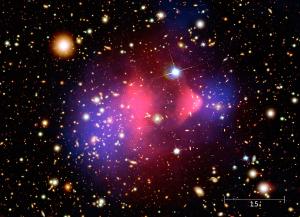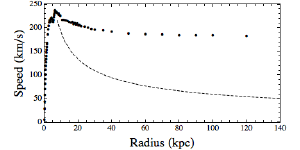Post
Dark Matters
6 March 2012
 NASA/CXC/M. Weiss
NASA/CXC/M. WeissI’ve been writing quite a bit about gravity lately, specifically about how astronomical observations confirm general relativity (and Newtonian gravity as an approximation to GR). But there are also cases were things don’t seem to add up. A case in point is the motions of stars in our galaxy.
Using the Doppler effect and a few other tricks we can measure the speeds of stars in our galaxy. If you plot a star’s speed vs its distance from the center of our galaxy, you get the result shown in the figure below, which is very, very strange. The dots represent the speeds we observe, while the dotted line represents the speed we expect according to our understanding of gravity. As you can see, the stars far way from galactic center move much faster than we would expect. Something is seriously wrong.
 Brian Koberlein
Brian KoberleinIf we measure the stellar speeds of other galaxies, we find the same type of discrepancy. Stars near the core of a galaxy move at the speeds we would expect, but stars far from the center move much faster than we would expect. So it isn’t the case that our galaxy is strange. All galaxies seem to behave the same way. This means that either our understanding of gravity is wrong, or something is causing the stars to move faster.
If our understanding gravity is wrong, then it can only be wrong on a galactic scale. We have seen that Newtonian gravity and general relativity work exceptionally well on the scale of our solar system, and it also works for binary stars, neutron stars and even other solar systems. One model that tries to take this into account is Modified Newtonian Dynamics, or MOND. The MOND model proposes a very small extra bit of acceleration due to gravity, about a tenth of a nanometer per square second. This extra term would be so small that we’d only notice it on the galactic and cosmic scales. If you calculate stellar speeds using MOND, you can get the theory to match observations pretty well.
The alternative is to suppose that something else must be going on. If our understanding of gravity is correct, then there must be more matter in the galaxy than we think. But this matter can’t be regular matter. If it were stars or gas or dust then we could observe it. This extra matter must be something that doesn’t emit light or block light. It must be an invisible form of matter known as dark matter. Dark matter seems like a crazy idea. To fix our broken model, let’s introduce an invisible something that can’t be regular matter (protons, neutrons, electrons), but otherwise still acts like regular matter. But it isn’t any more crazy than adding an extra acceleration term just to fit observation.
So how could we test either of these models? It turns out there is one way in which MOND and dark matter models differ. Since MOND proposes an extra term to gravity, the center of mass for a galaxy should be the center of mass we observe. In the dark matter model, the distribution of dark matter can be different than the distribution of regular matter, so the two types of matter can have different centers of mass. It is this latter case that has been observed in a colliding cluster of galaxies known as the Bullet Cluster. (You can see an animation of this collision). Dark matter it is.
There have been proposed corrections to MOND to account for the Bullet Cluster observations, but so far it looks like dark matter is real. By latest estimates dark matter makes up about 23% of our universe. Of course the big mystery is what dark matter actually is. We know it isn’t regular matter. It has to be something different.
I guess you could say we’re still in the dark on this one.